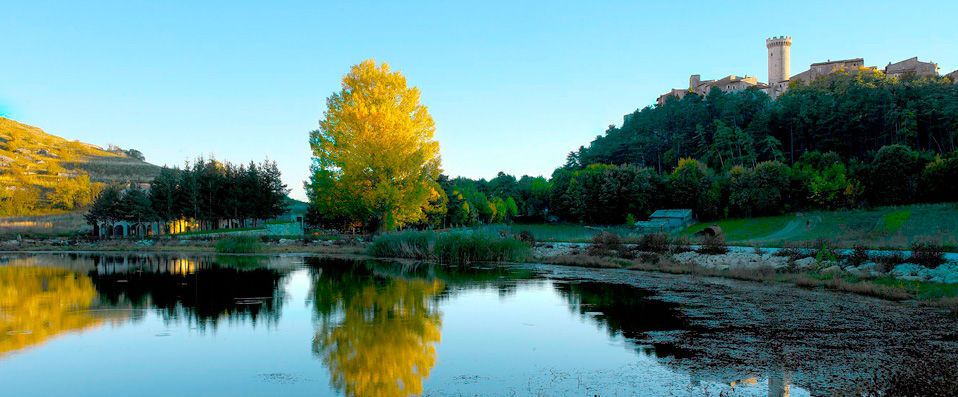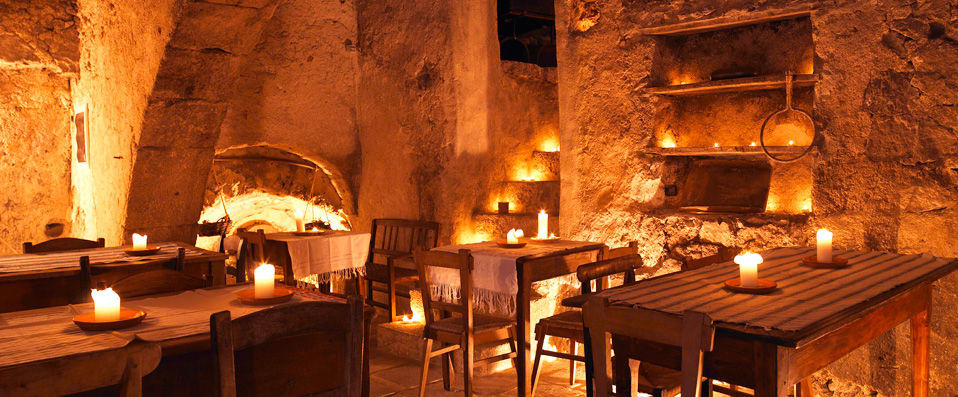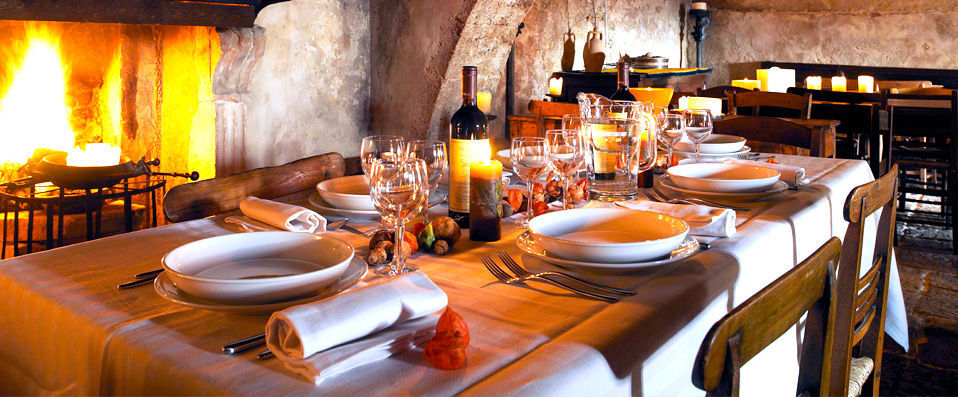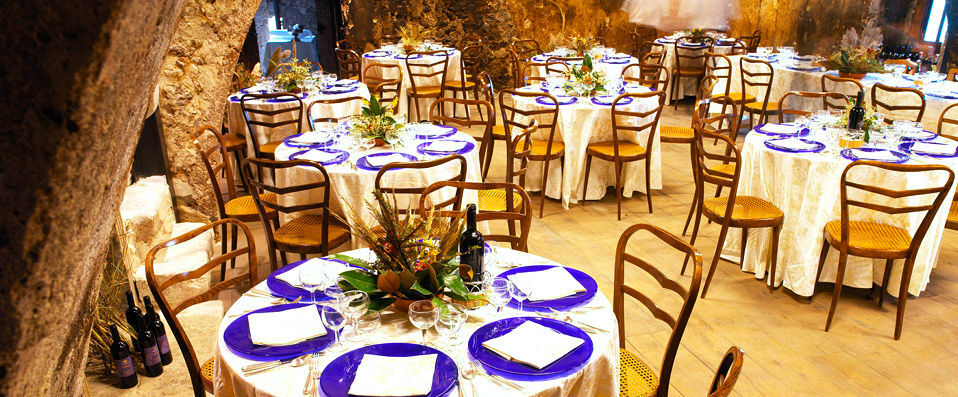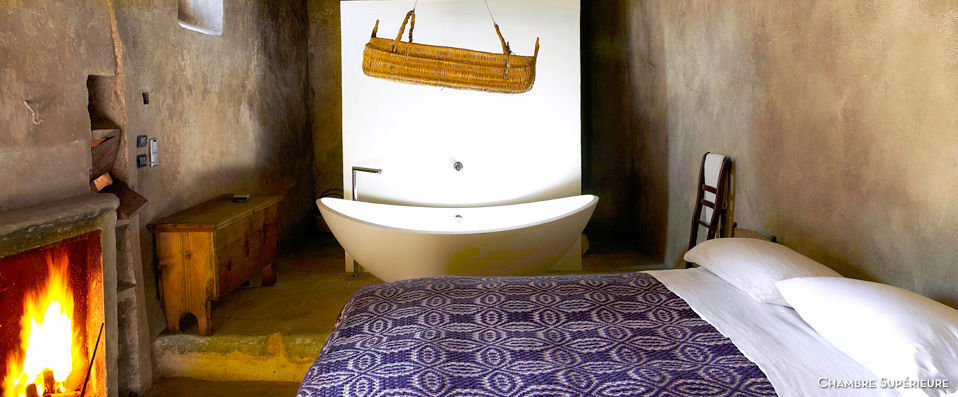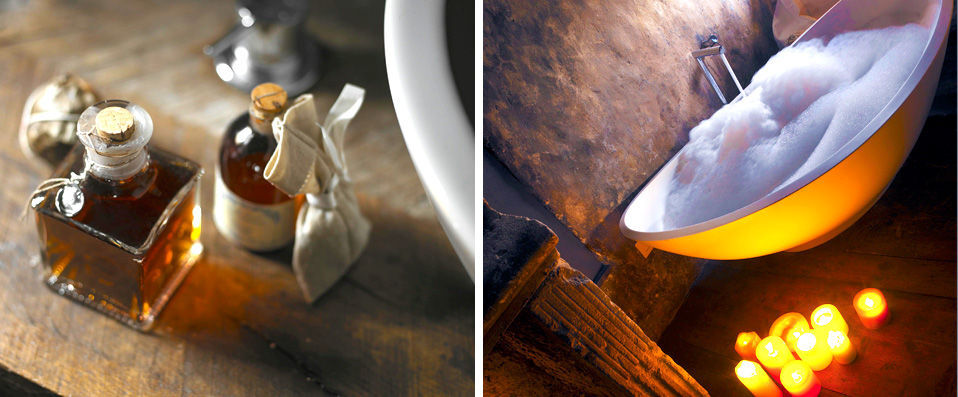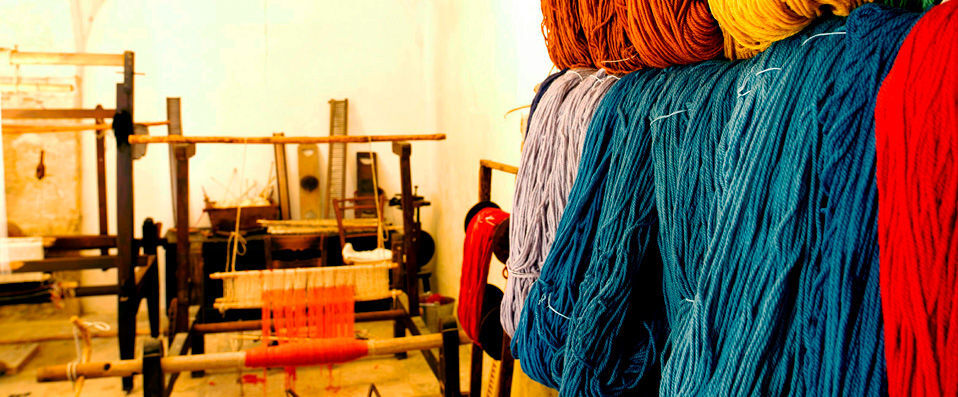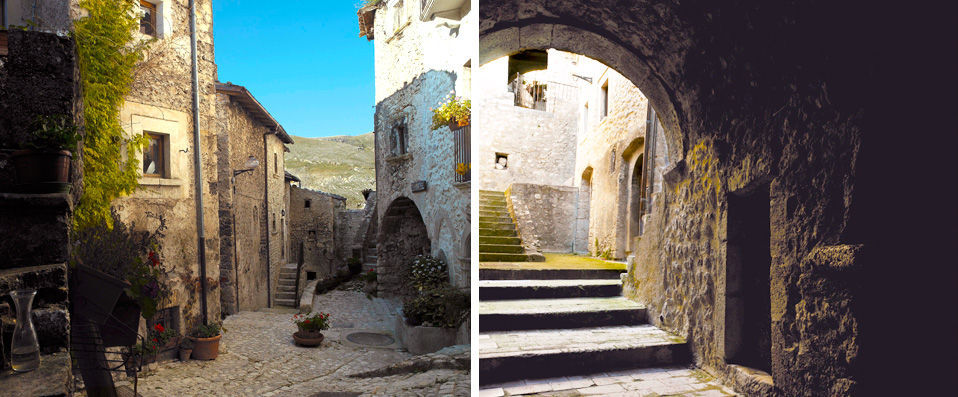This offer has ended
This flash sale is no longer available. Find all our current and upcoming sales:
View all offers The pretty alleyways and stone arches of the village: new delightful vistas at every turn.
The pretty alleyways and stone arches of the village: new delightful vistas at every turn. The simple rustic furnishings taking you back to a previous age.
The simple rustic furnishings taking you back to a previous age. The boutiques, art galleries and cafés tucked into ancient stone structures.
The boutiques, art galleries and cafés tucked into ancient stone structures. The unobtrusive modern comforts like underfloor heating and great bathrooms adding comfort to the rustic charm.
The unobtrusive modern comforts like underfloor heating and great bathrooms adding comfort to the rustic charm. The hotel’s commitment to sustainable agriculture and ‘slow food’.
The hotel’s commitment to sustainable agriculture and ‘slow food’.
Candlelight, open fires and ancient stone walls in the mountains of Abruzzo.
The hotel’s reception is in a separate building from the rooms – all of them converted village houses. The reception is adjoined by one of the two dining rooms: a refectory-style medieval hall with bare stone walls glowing in the firelight. There are candles in the alcoves, oak-beamed ceilings and original stone flags with the gentle wear of centuries on the floor. Farmhouse-style tables and simple wooden chairs await their occupants. There is a separate breakfast room too, with wooden floors and small tables and bentwood chairs. Bright azure blue dining plates make a lovely contrast with the glowing ochre of the rough stone walls.
Our room was a split-level adaptation of the whole house. Downstairs simple country furniture: a dining table and chairs and an antique chest, oak beams overhead and bare stone walls. Small windows set in the thick walls didn’t let in much light but that is part of the magical ambience; we would not have wanted it any other way. There were even soot stains in places from centuries of open fires and candle lighting. Open wooden steps led to the upstairs mezzanine bedroom. Simple and charming, with a king-size bed and open hearth with a blazing fire, even a bathtub if you wanted to bathe, country-style, in the warmth of the flames. We lay in bed that night, under blankets hand-woven in the village, in the quiet of the country air with only the occasional owl breaking the silence, mesmerised by the flickering firelight on the walls. It was truly magical. There are creature comforts too to supplement the rural simplicity of the surroundings. Under-floor heating and a lovely bathroom with modern fittings meant we were had all our modern comforts as well. No TV or phone, but there is Wi-Fi in every room!
Breakfast in the hotel was superb: locally grown produce, simple hams and cheeses, fresh fruit and Italian pastries. Dinner in the restaurant was excellent too. The whole village has been recognised by the Slow Food movement for its commitment to sustainable agriculture. The hotel is committed to sustainable local produce and everything was fresh and authentic; good local wine, friendly staff and fireside cheer in that lovely medieval atmosphere.
When you explore the village you find some great little boutiques and restaurants hidden away inside the old houses and we spent a couple of happy mornings browsing the shops and sampling the local cuisine. It was wonderful to explore the surrounding countryside and villages too. I couldn’t have been happier to have discovered this amazing region of Italy, and in particular the unique, unforgettable Sextantio Albergo Diffuso.
Classic Room
Stay in a Classic Room for 2 people (additional adult bed available)


-
- Surface area: 25m2
-
- Bed types: 1 large double bed
-
- Bathroom with: bath or shower, toilet, hair dryer and complimentary toiletries.
-
- Bedroom equipped with: heating
Superior Room
Stay in a Superior Room for up to 2 adults


-
- Surface area: 35m2
-
- Bed Types: 1 large double bed
-
- Bathroom with: bath or shower, toilet, hair dryer and complimentary toiletries
-
- Bedroom equipped with: lounge area, heating, fireplace, sofa
 Transfer service from Rome, Chapino or Pescara airports available for a surcharge (4 people max.)
Transfer service from Rome, Chapino or Pescara airports available for a surcharge (4 people max.) 24-hour Reception
24-hour Reception 30 Rooms (non-smoking)
30 Rooms (non-smoking) Wi-Fi available for free in the rooms and common areas of the hotel for VeryChic guests
Wi-Fi available for free in the rooms and common areas of the hotel for VeryChic guests "Locanda sotto gli Archi” Restaurant (open every evening 7:30pm-11pm)
"Locanda sotto gli Archi” Restaurant (open every evening 7:30pm-11pm) Bar Il Cantinone (open 6:30pm-11pm)
Bar Il Cantinone (open 6:30pm-11pm) Half board available at a rate of 50€ per person
Half board available at a rate of 50€ per person Library, cycling, horse riding, bike rental
Library, cycling, horse riding, bike rental Boutiques in the hotel
Boutiques in the hotel Free public parking
Free public parking The establishment does not provide disabled and limited mobility access
The establishment does not provide disabled and limited mobility access Pets are permitted in the establishment free of charge
Pets are permitted in the establishment free of charge
- The lentils of Santo Stefano are considered by connoisseurs be the best in Italy. It is from an old and rare species that is cultivated only in the poor terrain high in the mountains. Sample at La Bettola DI Geppetto, Via Principe Umberto, 67020 Santo Stefano di Sessanio. +39 0862 196 5309
- The Oratory of San Pellegrino in the village of Bominaco, half an hour’s journey from Santo Stefano di Sessanio. Wonderful interior covered in frescoes from the medieval period. 67020 Bominaco, L'Aquila, Italy.
- The National Park of Abruzzo: Nature reserve where if you are lucky you will spot the Marsican Brown Bear, Abruzzi Chamois, wolf and eagle. www.parcoabruzzo.it/page.php?id=251
Sextantio Albergo Diffuso ★★★★
Via Principe Umberto Snc
67020
Santo Stefano di Sessanio
Italy
Sextantio Albergo Diffuso **** is located in the Italian region of Abruzzo.
BY PLANE

Pescara Airport is the closest to the hotel but is mainly connected to airports within Italy. The best option is flying to Rome Fiumicino Airport and transfer from there to the hotel either by taking a connecting flight to Pescara, or by the hotel's transfer service available for a surcharge.
BY CAR

Rome Fumicino airport is around 2 hours' drive away via the E80, A24 and SS17.
GPS coordinates: 42.344203, 13.642867
- Local tourist taxes are included in the VeryChic prices
- Special condition: 2 night minimum stay 14th-16th April, Fridays and Saturdays in July, and the whole of August
- Menus adapted for special dietary requirements on request
- Baby cot (ages 0-3) available for free on request and with confirmation
- Additional adult bed (ages 12+) available at a rate of 37€ per night at the time of VeryChic booking - breakfasts included
- Maximum of 1 additional bed per room
- Check in from 3pm and check out by 11am
From Monday to Friday from 9 a.m. to 7 p.m. and on Saturdays, Sundays and French bank holidays from 9 a.m. to 6 p.m.
Local call charges may apply.

